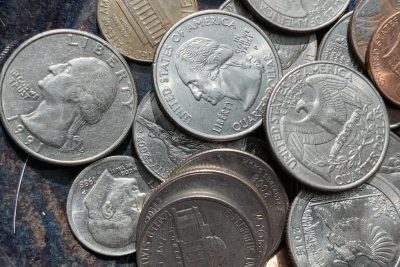Story of how a peculiarity that we almost no longer notice had a great use when coins were made of precious metals
Often behind the shape of objects there is only the aesthetic taste of those who created them. In most cases, however, there are also practical reasons why objects are made in a certain way, reasons which may be linked to functionality or the need to resolve some inconveniences linked to their use. For example, the handrails in the subway stations of the M1 line in Milan: they end up with a rounded shape, reminiscent of a question mark. It may seem like just a quirk of those who thought of it – the designers Franco Albini and Bob Noorda – but in reality it also has the function of not getting the bags or jackets of passengers moving in a hurry inside the stations entangled.
This is also the case with the knurling of coins, that series of small vertical lines engraved all over their edge: it may seem like a feature like many others, the result of chance or an aesthetic choice, but it once had a very important function. In the past, coins were made with precious materials, and their value depended on the quantity of gold, silver or copper they contained. Since ancient times, the payment system has therefore been based on the objective and intrinsic characteristics of currencies: it was very simple and intuitive, and has regulated economic transactions for almost the entire history of humanity.
There were some practical drawbacks, however. It happened that, depending on how the prices of precious metals went, the coins even had more value for the material they were made of than for the money equivalent. And this made counterfeiting particularly convenient: counterfeiters used the metal of the coins for other purposes, and minted fake coins from worthless metals. Doing so was also quite easy, because the designs and shapes were in most cases simple to reproduce.

A gold coin depicting the face of Alexander the Great and dating back to the third century BC, at the National History Museum in Sofia, Bulgaria (AP Photo/Petar Petrov)
Thus the practice of filing spread, with which counterfeiters scraped the edges to take the precious material. Sometimes, instead of being filed, the coins were cut slightly at the edges. Then they were put back into circulation, no one would have noticed anyway, but in the long run they became unusable, precisely because by dint of being filed down they lost their intrinsic value and were no longer accepted. Or they were brought back to the Mint, the body responsible for their minting, which was asked for a replacement: a lighter than normal coin was given back, and therefore evaluated as defective, to obtain in exchange a coin with the correct weight, with the right quantity of precious metal. The filing represented a great damage for the states, which were then forced to melt the filed coins and add precious material to mint them again.
For this reason, over time, in various European countries, the craftsmen who minted coins refined some techniques to make life more difficult for those who wanted to scrape or counterfeit them: for example by making the coins themselves more refined in shape.
Knurling began to spread in the seventeenth century, also thanks to the invention of the Castaing machine, which takes the name of the person who invented it, the French engineer Jean Castaing: the machine rotated the coin between two tools which engraved the edges with lines, thus creating the knurling, or with letters and drawings. By the end of the eighteenth century almost all coins had some type of decoration on the edges to prevent filing.

Some reconstructions attribute the invention of knurling to Isaac Newton, one of the most famous and influential scientists in history. In addition to being a mathematician, physicist and astronomer studied for centuries, Newton was also director of the British Mint at the end of the seventeenth century. In reality he contributed more than anything else to making the production of coins made in that way quicker and more efficient. The position of director of the United Kingdom Mint was more of a ceremonial role, which until then had not included any particular concrete involvement in the Mint’s activity. Newton took a very different, more interventionist approach and set out to address some inefficiencies in the manufacturing process.
Among these was the fact that not all the coins leaving the Mint had the same weight, and it happened that in random surveys they weighed slightly more or slightly less than expected. Newton improved and made the production processes more efficient, also by having artisans take training courses, and thus reduced this variability in the weight of the coins. In this sense he contributed to the end of the practice of filing coins, effectively making them more uniform in weight.

British coins featuring Queen Anne’s face dating back to 1702 (Royal Mint Museum)
The knurling, and in general the decoration of the edges, has now become part of the shape of the coins and is one of the elements studied by so-called numismatics, the study of coins from a historical, economic and artistic point of view.
Over time the knurling and decorations have also differentiated depending on the denomination of the coin and today they have taken on a new function: to make the denomination of the coin recognizable to blind people, who by touching the workmanship of the edge or the design on the faces can understand which coin they have in hand. In short, the decorations have remained as a legacy of the past, also because the deterrents for counterfeiters are no longer of much use: modern coins are no longer made of precious material and there is no longer any use in filing their edges. The 1,2 and 5 euro cent coins are made of copper-covered steel, the 10, 20 and 50 euro cent coins are made of a particular brass called “Nordic gold” (but which does not contain gold), and the 1 and 2 euro cent coins of nickel and brass. There are collector’s items that can be worth a lot, but they are few.
Today there is no longer any precious metal in coins because their value depends on the so-called legal tender, which is conferred by the monetary authorities, the central banks, which establish that those objects must be accepted as a form of payment. For example, it is the European Central Bank that establishes that the 1 euro coin is actually worth 1 euro, and that it must be accepted in payments with that value.
Coins have ceased to be precious objects in themselves since the nineteenth century, when the United Kingdom, which was then the world’s economic and financial reference, was the first country to introduce the gold standard, a monetary system anchored to the value of gold: for payments, banknotes or coins were used which in themselves were worth nothing, but whose convertibility into gold was always ensured by the central bank, which had to be held as a reserve in proportion to the quantity of banknotes and coins in circulation. In practical terms you could go to a bank and ask to exchange your banknotes and coins for gold and this therefore guaranteed them a certain value.

Some coins: quarters (25 cents), 10 cents, nickels (5 cents), and pennies (1 cent) (AP Photo/Jenny Kane)
From the First World War onwards, the costs of reconstruction and the economic crisis made this system unsustainable: governments needed money and could not issue it again unless they accumulated further gold reserves. So it was that some states began to decouple the value of their currencies from that of gold, and as time passed, money and gold began to no longer have any connection. At the beginning of the 1970s, under the pressure of domestic and international pressure, US President Richard Nixon decided to officially admit that the gold-based system no longer existed. From then on, a new monetary era began in which we still find ourselves today: that of the so-called fiduciary money or fiat (which is made, from Latin), whose value is equal to that declared by the relevant monetary authorities.
– Read also: Who decides which faces to put on the money?
Continue on the Post







